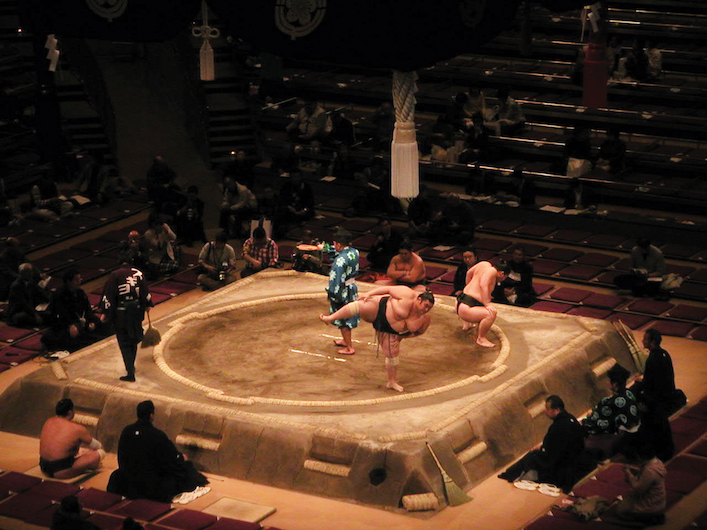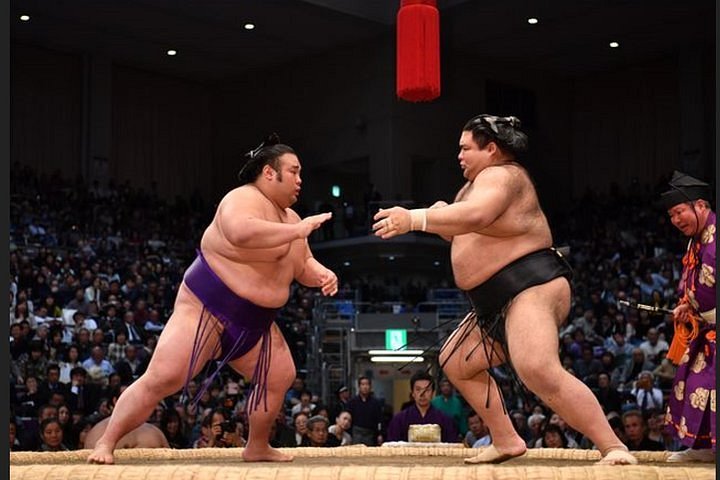The impact of Sumo wrestling has been a significant part of Japanese culture for centuries, dating back to the Edo period. Sumo wrestling is a traditional combat sport that originated in Japan. It is a physically demanding activity that involves two wrestlers pushing, shoving, and grappling until one is pushed out of the ring or thrown to the ground.

Sumo wrestling holds a vital role in Japanese society, embodying strength, discipline, and honor. Revered as national icons, Sumo wrestlers exemplify Japanese values. They must adhere to a strict training regime and specific code of conduct.
Sumo wrestling’s significance permeates daily Japanese life. Considered symbols of good luck, sumo wrestlers often receive invitations to participate in traditional Japanese festivals and ceremonies.
This post aims to shed light on the impact that Sumo wrestling has had on Japanese culture. Throughout the post, we will explore the history of sumo wrestling, its significance in Japanese culture, and how it has evolved over the years.
By the end of this blog post, readers will have a better understanding of the role that Sumo wrestling has played in shaping the culture of Japan and the unique character of its people. So, get ready to dive deep into the world of Sumo wrestling and its impact on Japanese culture.
Read: What Makes a Winning Sumo Wrestling Strategy?
Sumo Wrestling’s Origins
- Historical background of Sumo wrestling: Sumo wrestling dates back over 1,500 years ago in Japan.
- Customary practices in ancient Sumo: Originally, Sumo wrestling was a ritualistic practice to ensure bountiful harvests.
- Transformation of Sumo wrestling in Japan: Over time, Sumo wrestling became a professional sport and a symbol of Japanese culture.
Sumo wrestling, rooted in Japanese culture, originated over 1,500 years ago as a ritualistic practice. It has since evolved into a professional sport emblematic of Japanese culture.
The Nara period (710-794) in Japan marked the beginning of Sumo wrestling. It served as a religious ritual to secure a bountiful harvest. Farmers would compete at local shrines, demonstrating their strength amid intricate ceremonies.
In the Kamakura period (1192-1333), Sumo became a professional sport. Wrestlers began earning monetary rewards, and formal rules started taking shape with the introduction of the dohyo, or Sumo ring.
The Edo period (1603-1867) witnessed Sumo’s transformation into today’s sport. Professional Sumo boomed, wrestlers earned substantial income, and Sumo tournaments, or basho, drew massive crowds, symbolizing Japanese culture.
Yet, some early customs endured. Wrestlers still perform purification rituals before matches, often held at local shrines.
Today, Sumo’s importance in Japanese culture is undisputable. Major newspapers cover it extensively, and tournaments attract tourists worldwide. Sumo continues to be a significant symbol of Japan’s cultural heritage.
In summary, Sumo, once a religious practice for harvest, is now a beloved professional sport symbolizing Japanese culture. Its essence remains intact in Japan’s cultural fabric, continuing to thrive and captivate audiences worldwide.
Read: The Significance of Sumo Wrestling Rituals & Traditions
The Role of Sumo Wrestling in Japanese Culture
Sumo wrestling is not merely a sport in Japan but it holds a significant role in the country’s culture and history. It has a deep influence on Japanese society, economy, and even religion. In this blog chapter, we will discuss the various ways in which sumo wrestling impacts Japanese culture.
Innovative Tech Solutions, Tailored for You
Our leading tech firm crafts custom software, web & mobile apps, designed with your unique needs in mind. Elevate your business with cutting-edge solutions no one else can offer.
Start NowA. Influence of Sumo on Japanese Society
Sumo wrestling has a massive following in Japan, with thousands of fans flocking to the stadiums to watch tournaments. It is considered a national sport and has become an essential part of Japanese society. Sumo wrestlers are treated as celebrities, and their actions are keenly followed by the general public.
Sumo tournaments are also social events where families and friends gather to enjoy the matches and festivities. Traditional foods are served, and spectators take part in various games and activities. The tournaments bring people together from all over Japan, and it has become a way of fostering unity and community spirit.
B. How Sumo relates to Japan’s history
Sumo wrestling, rooted in Japan’s history, traces back to ancient times. Shinto, Japan’s indigenous religion, birthed sumo wrestling, using it as entertainment during rituals to please the gods.
In the Edo period, the Tokugawa shogunate endorsed sumo wrestling as an official sport. They recruited wrestlers to act as bodyguards, popularizing sumo among the samurai class. Sumo matches unfolded at shrines and temples, serving as a conduit for promoting culture and tradition.
C. The cultural significance of Sumo in Japan
Sumo wrestling is an important part of Japan’s cultural heritage and has become an emblem of Japanese identity. Many sumo rituals and customs have been passed down through generations and are still practiced today. For example, before the start of a match, the wrestlers perform a ritual called shiko, where they stomp their feet to drive away evil spirits.
Sumo has also become an essential element of Japanese popular culture. Sumo motifs can be seen in anime, manga, and video games, and many Japanese companies sponsor sumo wrestlers. Interestingly, Sumo wrestling has become a way of promoting Japanese culture and tradition globally.
In fact, Sumo wrestling has had a profound impact on Japanese culture and continues to play a vital role in promoting unity, community spirit, and national identity. It is truly an art form that has stood the test of time and will continue to be an essential part of Japan’s cultural heritage for generations to come.
Read: How Do Sumo Wrestlers Maintain Their Weight?
Sumo Wrestling Tournaments
Sumo wrestling tournaments have been an integral part of Japanese culture for centuries. These competitions are highly prestigious and popular among Japanese people, attracting large crowds from all over the country. In this section, we will explore the explanation of sumo tournaments, the importance of sumo wrestling competitions, and the Grand Sumo tournaments.
A. Explanation of Sumo Tournaments
Sumo tournaments, also known as Basho, are six major annual competitions held in different parts of Japan. These tournaments last for 15 days each, and each bout usually takes only a few seconds. The rules are straightforward: one wrestler wins if he can force his opponent out of a ring, or make any part of his opponent’s body other than the soles of his feet touch the ground. Three or more judges arbitrate each bout, using various hand signals to indicate the winner.
The traditional Japanese style of ritual and discipline is a significant part of the tournaments. Before the start of each day’s matches, the referees and wrestlers perform a solemn ceremony that involves clapping, stamping their feet, and tossing salt into the ring, a symbolic gesture to purify and sanctify the space. The wrestlers wear elaborate loincloths known as mawashi, and the most ancient of samurai rituals have been incorporated into the Sumo wrestling culture.
B. The Importance of Sumo Wrestling Competitions
Japanese culture values Sumo wrestling greatly, holding it as a source of national pride and identity. It offers athletes a platform to attain fame and recognition. In fact, society treats Sumo wrestlers with immense respect, equating their status to historic samurai. From a young age, these athletes undergo training in diverse martial arts and bodybuilding exercises. A master teacher, or Oyakata, supervises their rigorous, multi-year training.
For many aspiring young Japanese men, becoming a sumo wrestler is a dream that they will do anything to achieve. It’s a prestigious job with excellent pay, and their life in the Sumo stables is one of discipline, hard work, and sacrifice. Sumo wrestlers are idolized by their fans and perform in front of packed stadiums, and their professional reputation is crucial to their future success in the sport.
C. Explanation of Grand Sumo Tournaments
The Grand Sumo tournaments are the most prestigious and important of all the sumo tournaments, attracting the largest crowds and the most attention. There are six Grand tournaments in a year: three in Tokyo, one each in Osaka, Nagoya, and Fukuoka. Each of these occurs for fifteen days, with the top ranked wrestlers competing against each other for championship titles and cash prizes.
Sumo wrestling has evolved into a complex hierarchy of ranks and titles, with various categories of wrestlers depending on their performance in the competition. The highest rank in Sumo wrestling is Yokozuna, the Grand Champion, who is considered to be the most celebrated and respected of all Sumo wrestlers. The tournament marks the promotion of wrestlers from one rank to another, according to their performances, and the Yokozuna will fight only the strongest and most skilled wrestlers.
All in all, Sumo wrestling tournaments play an essential role in Japanese culture. They provide a source of pride and identity for Japan and provide a platform for athletes to achieve fame and success. The Grand Sumo Tournaments are the most important of all the competitions, attracting the largest crowds and attention. Sumo wrestling continues to captivate and inspire people worldwide, and its ancient traditions are still kept alive in Japan.
Read: The Diet & Lifestyle of a Sumo Wrestler: A Guide
Famous Sumo Wrestlers
Sumo wrestling has been a significant part of Japanese culture for centuries, and it has brought forth many famous sumo wrestlers who have become an icon in the country. Here are some of the significant wrestlers in Japan’s history and their contributions to the sport.
A. History of significant wrestlers in Japan
- Tanikaze Kajinosuke
- Onogawa Kisaburo
- Onokuni Yasushi
Tanikaze Kajinosuke, also known as the “Father of Sumo,” revolutionized the sport by coming up with various techniques that are still used today. Onogawa Kisaburo was the first wrestler to make 500 wins in sumo, while Onokuni Yasushi was recognized as one of the greatest sumo wrestlers of all time and won several tournaments during his time.
B. Profile of popular Sumo wrestlers
- Hakuho Sho
- Kisenosato Yutaka
- Kakuryu Rikisaburo
Hakuho Sho is considered the greatest sumo wrestler of all time, having won over forty tournaments and holding numerous records. Kisenosato Yutaka was the first Japan-born wrestler to achieve the Yokozuna, the highest rank in sumo, in almost twenty years. Kakuryu Rikisaburo is a popular wrestler famous for his agility and speed in the ring.
C. Explanation of the different wrestling categories
- Makuuchi
- Juryo
- Makushita
- Sandanme
- Jonidan
- Jonokuchi
Sumo wrestling has six major categories, with Makuuchi being the highest and Jonokuchi being the lowest. Each category has several wrestlers, and promotion or demotion from one category to another is based on the wrestler’s win/loss record during tournaments.
Overall, sumo wrestling has remained an essential part of Japanese culture and is loved by numerous fans worldwide. These famous wrestlers have contributed to the sport’s growth and made it more popular than ever before.
Read: Understanding Sumo Wrestling Ranking System

Sumo Wrestling and Modern Culture
A. Sumo’s Influence on Modern Japanese Society
Sumo wrestling has been an integral part of Japanese culture for centuries, and its influence is still evident in modern society. The sport is not only a form of entertainment, but it also showcases the strength and discipline that are important values in Japanese culture.
Seamless API Connectivity for Next-Level Integration
Unlock limitless possibilities by connecting your systems with a custom API built to perform flawlessly. Stand apart with our solutions that others simply can’t offer.
Get StartedSumo wrestlers, revered as role models, earn public respect for their dedication and rigorous training, including strict diets and intensive workouts.
Sumo tournaments, held year-round, draw large spectator crowds. Televisions broadcast these events widely. Prestigious tournaments, like Tokyo’s Grand Sumo Tournament, garner international attention.
Read: What are the Basic Rules of Sumo Wrestling?
B. How Sumo Wrestling is Regarded by the Youth and Foreigners
Despite the popularity of Sumo wrestling in Japan, it is not always regarded positively by the younger generation, who are more interested in other sports and forms of entertainment. Many young people view Sumo wrestling as outdated, and some even see it as boring.
However, among foreign visitors to Japan, Sumo wrestling is often seen as a fascinating and unique aspect of Japanese culture. Many tourists attend Sumo tournaments or visit Sumo stables to watch the wrestlers training and to learn more about the sport.
Recently, Sumo wrestling has captivated foreigners residing in Japan. Some have even joined amateur Sumo tournaments and clubs established in major cities nationwide.
C. The Polarization of Sumo’s Importance in Japan
While Sumo wrestling remains an important part of Japanese culture, there is some polarization over the level of importance placed on the sport. Some people believe that Sumo wrestling has lost some of its significance in recent years, with declining interest from younger generations and concerns over scandals and corruption within the sport.
Conversely, some argue that Sumo wrestling maintains significant cultural importance in Japan and merits preservation and celebration. They highlight the ongoing popularity of Sumo tournaments and the continued public respect for Sumo wrestlers.
Despite these differing viewpoints, it is clear that Sumo wrestling continues to have a significant impact on Japanese culture. Its blend of tradition, athleticism, and discipline makes it a unique and compelling aspect of the country’s rich cultural heritage.
Read: How to Train Like a Sumo Wrestler: Tips & Techniques
Conclusion
Sumo wrestling in Japan has deep cultural roots and is regarded as a sacred sport. Through this post, we have gained a better understanding of the history and significance of Sumo wrestling on Japanese culture. Sumo is more than just a sport in Japan, it is a symbol of tradition, power, respect, and discipline. Its impact on Japan’s cultural heritage is immeasurable.
As we conclude, Sumo wrestling has become a significant part of Japanese culture and has earned its place in the annals of history. Its essence has not only attracted the Japanese but also international visitors who seek to explore Japan’s rich heritage. Sumo wrestling is not just a sport but a way of life. It teaches us the importance of discipline, perseverance, and respect. May Sumo’s legacy continue to live on for generations to come!
Read: The History of Sumo Wrestling: A Deep Dive
Before You Go…
Hey, thank you for reading this blog to the end. I hope it was helpful. Let me tell you a little bit about Nicholas Idoko Technologies. We help businesses and companies build an online presence by developing web, mobile, desktop, and blockchain applications.
We also help aspiring software developers and programmers learn the skills they need to have a successful career. Take your first step to becoming a programming boss by joining our Learn To Code academy today!
Be sure to contact us if you need more information or have any questions! We are readily available.










